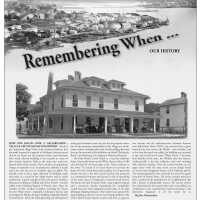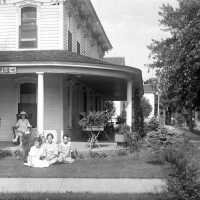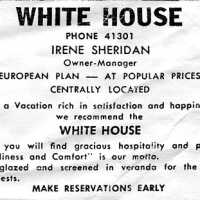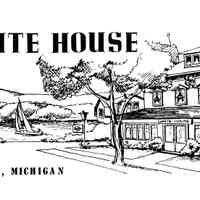White House

2021.87.72
HOW ONE HOUSE—NOW A GALLERY-SHOP—TELLS US A BIT OF SAUGATUCK HISTORY Much of the “traditional village” look of the commercial district that has made Saugatuck so popular in Michigan is because many (but by no means not all) property owners and merchants have wisely allowed buildings to be recycled in terms of their interior function while at the same time retain the historic form of the exterior. Now and then an appropriate change in materials or an inconspicuous addition is made and a few (not but not an overload) signs are added. The friendly result is that a large collection of buildings retain their place as a record of the village history and its varied architecture. A good example of this is the present Toulouse Restaurant building at Griffith and Culver Streets—recently added to the Michigan Register of Historic Sites. There are number of other excellent examples, including the Tuscan Pot (321 Water Street—originally as Kleeman’s Tavern), and in Douglas the Bentley Antiques building (originally Marsh’s General Store). All of the urban planning and development advice these days argues that preservation efforts such as these make good economic sense, not just for the property owner but for the economic sustainability of the village as a whole. Some of these, including the Good Goods building discussed here are documented in the exhibition and book “Raising the Roof,” now showing at the Saugatuck Historical Museum. The Dole House/ Good Goods is a very fine Italianate home, historically known as the White House, built in 1889 and described by the local paper as the “finest residence in the town.” For much of its recent history it has been the home of Good Goods shop and art gallery. It is of particular interest because it has been nicely recycled and preserved as a commercial structure and because it tells us something of the many layers of Saugatuck’s economic/social history. The house was built for James Dole, a ship engineer/captain and a contractor, thereby representing the considerable wealth that came from Saugatuck’s former place in the Lake Michigan shipping business. Dole’s father had operated the large building on the next corner (now Pumpernickels) as the Union Hotel (it later became a tavern and then as a grocery store). The Dole/Good Goods house was actually built in two sections and the uncharacteristic Italianate dormers were added later. About 1909 it was converted into a guest house/inn by new owners, the Weible - Lown families, and at this time the porch was added, the building was increased in size, and it took on the name “White House.” Like many local families of the time, the Weibels were also farmers. Architecturally it has fine Italianate wide roof overhang with elaborate brackets. Note the arched windows on the upper story—with the same acorn cut-out design found on several other Saugatuck houses of this Italianate period. The wraparound porch (now enclosed) was one of the grand attractions of Mason Street. The house certainly must have been a symbol of the gentrification of a neighborhood that had a history of disreputable taverns. The current owners have demonstrated how good preservation stewardship can complement a very contemporary business enterprise—and downtown Saugatuck is all the better for it. By Jim Schmiechen
Remembering When
Winthers, Sally
Digital data in CatalogIt
Carey, Rob 1928-2019Sheridan, John "Jack" O. 1938-Schmiechen, James A.Randolph, SandraGood Goods gallery 1989-2023Lown, Fanny (Warner) Weible 1864-1940Good Goods/White House/James Dole house/106 MasonSheridan, Irene (Weible) 1883-1967
Local Observer
01/01/2022
08/11/2024






